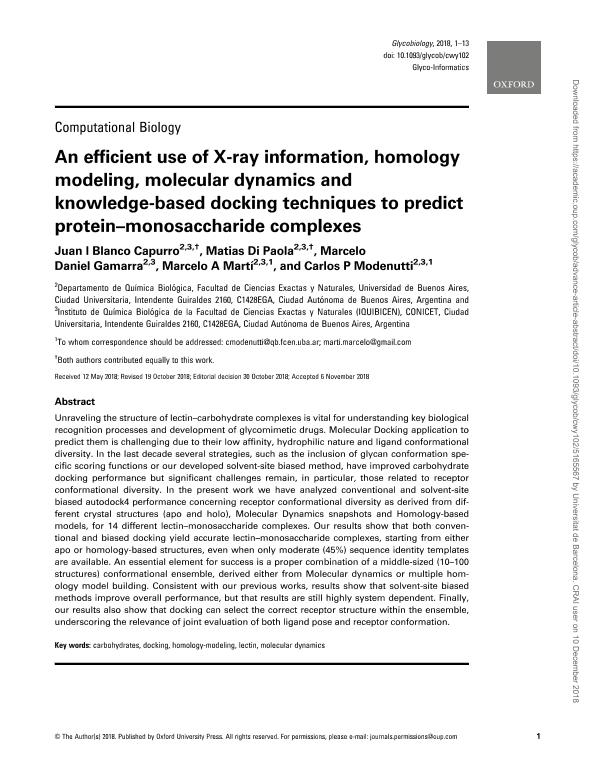Mostrar el registro sencillo del ítem
dc.contributor.author
Blanco Capurro, Juan Ignacio

dc.contributor.author
Di Paola, Matías Ezequiel

dc.contributor.author
Gamarra, Marcelo Daniel

dc.contributor.author
Marti, Marcelo Adrian

dc.contributor.author
Modenutti, Carlos Pablo

dc.date.available
2020-02-18T21:30:27Z
dc.date.issued
2018-11
dc.identifier.citation
Blanco Capurro, Juan Ignacio; Di Paola, Matías Ezequiel; Gamarra, Marcelo Daniel; Marti, Marcelo Adrian; Modenutti, Carlos Pablo; An efficient use of X-ray information, homology modeling, molecular dynamics and knowledge-based docking techniques to predict protein-monosaccharide complexes; Oxford University Press; Glycobiology; 29; 2; 11-2018; 124-136
dc.identifier.issn
0959-6658
dc.identifier.uri
http://hdl.handle.net/11336/97997
dc.description.abstract
Unraveling the structure of lectin-carbohydrate complexes is vital for understanding key biological recognition processes and development of glycomimetic drugs. Molecular Docking application to predict them is challenging due to their low affinity, hydrophilic nature and ligand conformational diversity. In the last decade several strategies, such as the inclusion of glycan conformation specific scoring functions or our developed solvent-site biased method, have improved carbohydrate docking performance but significant challenges remain, in particular, those related to receptor conformational diversity. In the present work we have analyzed conventional and solvent-site biased autodock4 performance concerning receptor conformational diversity as derived from different crystal structures (apo and holo), Molecular Dynamics snapshots and Homology-based models, for 14 different lectin-monosaccharide complexes. Our results show that both conventional and biased docking yield accurate lectin-monosaccharide complexes, starting from either apo or homology-based structures, even when only moderate (45%) sequence identity templates are available. An essential element for success is a proper combination of a middle-sized (10-100 structures) conformational ensemble, derived either from Molecular dynamics or multiple homology model building. Consistent with our previous works, results show that solvent-site biased methods improve overall performance, but that results are still highly system dependent. Finally, our results also show that docking can select the correct receptor structure within the ensemble, underscoring the relevance of joint evaluation of both ligand pose and receptor conformation.
dc.format
application/pdf
dc.language.iso
eng
dc.publisher
Oxford University Press

dc.rights
info:eu-repo/semantics/openAccess
dc.rights.uri
https://creativecommons.org/licenses/by-nc-sa/2.5/ar/
dc.subject
CARBOHYDRATES
dc.subject
DOCKING
dc.subject
HOMOLOGY-MODELING
dc.subject
LECTIN
dc.subject
MOLECULAR DYNAMICS
dc.subject.classification
Otras Ciencias Químicas

dc.subject.classification
Ciencias Químicas

dc.subject.classification
CIENCIAS NATURALES Y EXACTAS

dc.title
An efficient use of X-ray information, homology modeling, molecular dynamics and knowledge-based docking techniques to predict protein-monosaccharide complexes
dc.type
info:eu-repo/semantics/article
dc.type
info:ar-repo/semantics/artículo
dc.type
info:eu-repo/semantics/publishedVersion
dc.date.updated
2019-10-24T19:07:28Z
dc.journal.volume
29
dc.journal.number
2
dc.journal.pagination
124-136
dc.journal.pais
Reino Unido

dc.journal.ciudad
Oxford
dc.description.fil
Fil: Blanco Capurro, Juan Ignacio. Consejo Nacional de Investigaciones Científicas y Técnicas; Argentina
dc.description.fil
Fil: Di Paola, Matías Ezequiel. Universidad de Buenos Aires; Argentina
dc.description.fil
Fil: Gamarra, Marcelo Daniel. Universidad de Buenos Aires; Argentina
dc.description.fil
Fil: Marti, Marcelo Adrian. Consejo Nacional de Investigaciones Científicas y Técnicas; Argentina
dc.description.fil
Fil: Modenutti, Carlos Pablo. Consejo Nacional de Investigaciones Científicas y Técnicas; Argentina
dc.journal.title
Glycobiology

dc.relation.alternativeid
info:eu-repo/semantics/altIdentifier/url/https://academic.oup.com/glycob/article/29/2/124/5165567
dc.relation.alternativeid
info:eu-repo/semantics/altIdentifier/doi/https://doi.org/10.1093/glycob/cwy102
Archivos asociados
